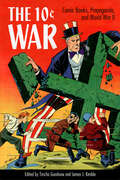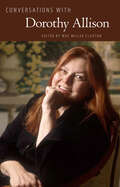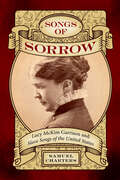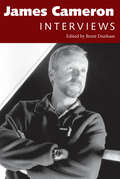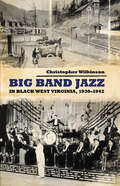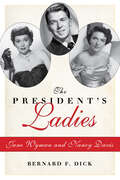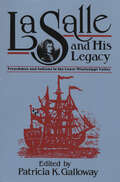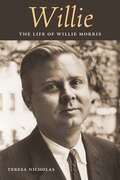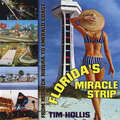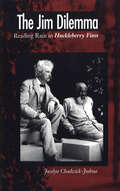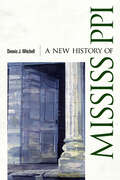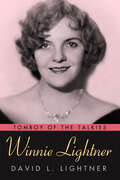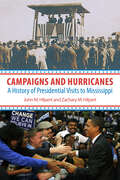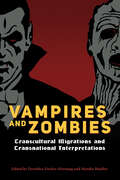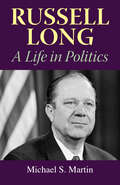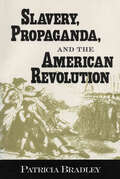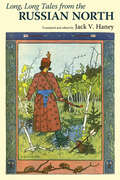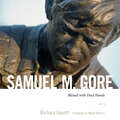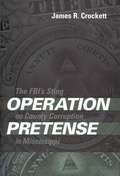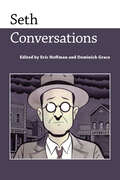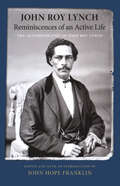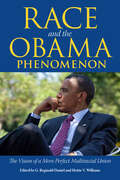- Table View
- List View
The 10 Cent War: Comic Books, Propaganda, and World War II
by Trischa Goodnow and James J. KimbleContributions by Derek T. Buescher, Travis L. Cox, Trischa Goodnow, Jon Judy, John R. Katsion, James J. Kimble, Christina M. Knopf, Steven E. Martin, Brad Palmer, Elliott Sawyer, Deborah Clark Vance, David E. Wilt, and Zou YizhengOne of the most overlooked aspects of the Allied war effort involved a surprising initiative--comic book propaganda. Even before Pearl Harbor, the comic book industry enlisted its formidable army of artists, writers, and editors to dramatize the conflict for readers of every age and interest. Comic book superheroes and everyday characters modeled positive behaviors and encouraged readers to keep scrapping. Ultimately, those characters proved to be persuasive icons in the war's most colorful and indelible propaganda campaign.The 10 Cent War presents a riveting analysis of how different types of comic books and comic book characters supplied reasons and means to support the war. The contributors demonstrate that, free of government control, these appeals produced this overall imperative. The book discusses the role of such major characters as Superman, Wonder Woman, and Uncle Sam along with a host of such minor characters as kid gangs and superhero sidekicks. It even considers novelty and small presses, providing a well-rounded look at the many ways that comic books served as popular propaganda.
Conversations with Dorothy Allison (Literary Conversations Series)
by Mae Miller ClaxtonSince the publication of her groundbreaking novel, Bastard Out of Carolina, Dorothy Allison (b. 1949) has been known—along with Larry Brown and Lee Smith—as a purveyor of the working-class, contemporary South. Allison has frequently used her position, through passionate lectures and enthusiastic interviews, to give voice to issues dear to her: poverty, working-class life, domestic violence, feminism and women’s relationships, the contemporary South, and gay/lesbian life. Often called a “writer-rock star” and a “cult icon,” Allison is a true performer of the written word. At the same time, Allison also takes the craft of writing very seriously. In this collection, spanning almost two decades, Allison the performer and Allison the careful craftsperson both emerge, creating a portrait of a complex woman. In the absence of a biography of Allison’s life, Conversations with Dorothy Allison presents Allison’s perspectives on her life, literature, and her conflicted role as a public figure.
Songs of Sorrow: Lucy McKim Garrison and Slave Songs of the United States (American Made Music Series)
by Samuel ChartersIn the spring of 1862, Lucy McKim, the nineteen-year-old daughter of a Philadelphia abolitionist Quaker family, traveled with her father to the Sea Islands of South Carolina to aid him in his efforts to organize humanitarian aid for thousands of newly freed slaves. During her stay she heard the singing of the slaves in their churches, as they rowed their boats from island to island, and as they worked and played. Already a skilled musician, she determined to preserve as much of the music as she could, quickly writing down words and melodies, some of them only fleeting improvisations. Upon her return to Philadelphia, she began composing musical settings for the songs and in the fall of 1862 published the first serious musical arrangements of slave songs. She also wrote about the musical characteristics of slave songs, and published, in a leading musical journal of the time, the first article to discuss what she had witnessed. In Songs of Sorrow renowned music scholar Samuel Charters tells McKim's personal story. Letters reveal the story of young women's lives during the harsh years of the war. At the same time that her arrangements of the songs were being published, a man with whom she had an unofficial “attachment” was killed in battle, and the war forced her to temporarily abandon her work. In 1865 she married Wendell Phillips Garrison, son of abolitionist William Lloyd Garrison, and in the early months of their marriage she proposed that they turn to the collection of slave songs that had long been her dream. She and her husband—a founder and literary editor of the recently launched journal The Nation—enlisted the help of two associates who had also collected songs in the Sea Islands. Their book, Slave Songs of the United States, appeared in 1867. After a long illness, ultimately ending in paralysis, she died at the age of thirty-four in 1877. This book reclaims the story of a pioneer in ethnomusicology, one whose influential work affected the Fisk Jubilee Singers and many others.
James Cameron: Interviews (Conversations with Filmmakers Series)
by Brent DunhamJames Cameron (b. 1954) is lauded as one of the most successful and innovative filmmakers of the last thirty years. His films often break records, both in their massive budgets and in their box-office earnings. They include such hits as The Terminator, Aliens, The Abyss, Titanic, and Avatar. Part scientist, part dramatist, Cameron combines these two qualities into inventive and captivating films that often push the boundaries of special effects to accommodate his imagination. James Cameron: Interviews chronicles the writer-director's rise through the Hollywood system, highlighted by his “can-do” attitude and his insatiable drive to make the best film possible. As a young boy growing up in Canada, Cameron imagined himself an astronaut, a deep-sea explorer, a science fiction writer, or a filmmaker. Transplanted to southern California, he would go on to realize many of those boyhood fantasies. This collection of interviews provides glimpses of the filmmaker as he advances from Roger Corman's underling to “king of the world.” The interviews are drawn from a number of sources including TV appearances and conversations on blogs, which have never been published in print. Spanning more than twenty years, this collection constructs a concise and thorough examination of Cameron, a filmmaker who has almost single-handedly ushered Hollywood into the twenty-first century.
Big Band Jazz in Black West Virginia, 1930–1942 (American Made Music Series)
by Christopher WilkinsonAssociation of Recorded Sound Collections Awards for ExcellenceBest Research in Recorded Jazz Music–Certificate of Merit (2013)The coal fields of West Virginia would seem an unlikely market for big band jazz during the Great Depression. That a prosperous African American audience dominated by those involved with the coal industry was there for jazz tours would seem equally improbable. Big Band Jazz in Black West Virginia, 1930-1942 shows that, contrary to expectations, black Mountaineers flocked to dances by the hundreds, in many instances traveling considerable distances to hear bands led by Count Basie, Duke Ellington, Andy Kirk, Jimmie Lunceford, and Chick Webb, among numerous others. Indeed, as one musician who toured the state would recall, "All the bands were goin' to West Virginia."The comparative prosperity of the coal miners, thanks to New Deal industrial policies, was what attracted the bands to the state. This study discusses that prosperity as well as the larger political environment that provided black Mountaineers with a degree of autonomy not experienced further south. Author Christopher Wilkinson demonstrates the importance of radio and the black press both in introducing this music and in keeping black West Virginians up to date with its latest developments. The book explores connections between local entrepreneurs who staged the dances and the national management of the bands that played those engagements. In analyzing black audiences' aesthetic preferences, the author reveals that many black West Virginians preferred dancing to a variety of music, not just jazz. Finally, the book shows bands now associated almost exclusively with jazz were more than willing to satisfy those audience preferences with arrangements in other styles of dance music.
Electro- and Magneto-Mechanics of Soft Solids: Constitutive Modelling, Numerical Implementations, and Instabilities (CISM International Centre for Mechanical Sciences #610)
by Kostas Danas Oscar Lopez-PamiesThis book examines the electro- and magneto-mechanics of soft composite materials and structures, and focuses on magnetorheological elastomers (MREs) and dielectric elastomer composites (DECs), which are composite materials that comprise ferromagnetic and high-dielectric/conducting filler nano- and micro-particles embedded in a soft polymeric matrix. This gives rise to a coupled magneto- and electro-mechanical response at the macroscopic (order of millimeters and larger) scale when they are subjected to magneto- electro-mechanical external stimuli. While such MRE and DEC materials and devices can become unstable at some critical electro-magneto-mechanical loading, their response may be well controlled in the post-instability regime. Moreover, recent advances on the complete electro-magneto-mechanical coupling are presented. All those aforementioned features motivate the operation of these devices in this unstable region to obtain controlled pattern formation, soft robotic motion andartificial muscles, controllable band-gap acoustic and electromagnetic properties, energy harvesting as well as actively controlled stiffness (for cell-growth). The book contains four individual chapters covering work on the fundamentals (O. Lopez-Pamies) and the modeling (M. Gei) of electroactive solids, the modeling of magnetoactive solids (K. Danas), and the analysis of elastic instabilities (Y. Fu).
Elusive Phenomena, Unwieldy Things: Historical Perspectives on Experimental Control (Archimedes #71)
by Jutta Schickore William R. NewmanThis open access book provides a historical treatment of scientific control in experimentation in the longue durée. The introduction distinguishes four related strands in the history of experimental control: the development of practices to stabilize experimental conditions; the career of the comparative design; the unfolding of methodological discussions about control practices and designs; and the history of the term “control”. Each chapter brings these distinctions to bear on specific historical episodes. The focus is on experiments with complex, elusive phenomena such as perception and learning, irregular movements, and unobservable elements. Such experiments bring control issues to the fore because they are difficult to design and stabilize and often controversial. Together, the chapters show that the local context shapes what exactly is controlled, how control can be accomplished, and how controls are justified. They also show that control strategies and methodological ideas often remain stable for a long time and change only gradually. This book, as well as the volume on analysis and synthesis in experimentation by the same editors, contains contributions by an array of experts from multiple disciplines, making it suitable for historians and philosophers of science and students alike.
The Pricing Compass: Finding the Solution to Your Pricing Puzzle (Business Guides on the Go)
by Jan Y. YangThis book provides business owners and practitioners with a comprehensive and pragmatic guide to pricing, which lays out the essential steps to professionalizing pricing from day one all the way to a more mature stage. It not only details the key activities leading to result-driven pricing strategies and execution but also addresses the most important pillars of good pricing governance. To do so, the book covers a broad range of pricing topics relevant at different stages of business evolution, e.g. determining the starting point of the pricing journey, identifying unique selling propositions, gauging willingness to pay (WTP), conducting effective customer profiling, improving promotions, and managing distribution from a pricing standpoint. The book fills a gap in the current pricing literature, which largely consists of descriptive and retrospective narratives cataloging past pricing strategies and tactics that never delve into the underlying rationale and methodologies. It provides readers with clear, actionable insights on how to price their own products and services.
The President’s Ladies: Jane Wyman and Nancy Davis
by Bernard F. DickRonald Reagan, a former actor and one of America's most popular presidents, married not one but two Hollywood actresses. This book is three biographies in one, discovering fascinating connections among Jane Wyman (1917–2007), Ronald Reagan (1911–2004), and Nancy Davis (b. 1921–2016). Jane Wyman, who married Reagan in 1940 and divorced him seven years later, knew an early life of privation. She gravitated to the movies and made her debut at fifteen as an unbilled member of the chorus, then toiled as an extra for four years until she finally received billing. She proved herself as a dramatic actress in The Lost Weekend, and the following year, she was nominated for an Oscar for The Yearling and soon won for her performance in Johnny Belinda, in which she did not speak a single line. Other Oscar nominations followed, along with a Golden Globe for her portrayal of Angela Channing in Falcon Crest. Conversely, Nancy Davis led a relatively charmed life, the daughter of an actress and the stepdaughter of a neurosurgeon. Surrounded by her mother's friends—Walter Huston, Spencer Tracy, Katharine Hepburn, Lillian Gish, and Alla Nazimova, her godmother—Davis started in the theater, then moved on to Hollywood, where she enjoyed modest success, and finally began working in television. When she married Reagan in 1952, she unwittingly married into politics, eventually leaving acting to concentrate on being the wife of the governor of California, and then the wife of the president of the United States. In her way, Davis played her greatest role as Reagan's friend, confidante, and adviser in life and in politics. This book considers three actors who left an indelible mark on both popular and political culture for more than fifty years.
La Salle and His Legacy: Frenchmen and Indians in the Lower Mississippi Valley
by Patricia K. GallowayTo most people it probably seems that La Salle and his men, permanently fixed in the pantheon of explorers of the North American continent, need little further introduction. The fact is that this whole early period of exploration and colonization by the French in the southeastern United States has received far less scholarly attention than the corresponding English and Spanish activities in the same area, and even the existing scholarship has failed to focus clearly upon the Indian tribes whose attitudes toward the European new comers were crucial to their very survival. In this collection of essays marking the tricentennial of René-Robert Cavelier de La Salle's 1682 expedition into the Lower Mississippi Valley, thirteen scholars from a variety of disciplines assess his legacy and the significance of French colonialism in the Southeast. These scholars in the fields of French colonial history and the ethnohistory of the Indians of the Louisiana Colony deal with a diversity of topics ranging from La Salle's expedition itself and its place in the context of New World colonialism in general to the interaction of French settlers with native Indian tribes.
Willie: The Life of Willie Morris
by Teresa NicholasIn 2000, readers voted Willie Morris (1934–1999) Mississippi's favorite nonfiction author of the millennium. After conducting over fifty interviews and combing through over eighty boxes of papers in the archives at the University of Mississippi, many of which had never been seen before by researchers, Teresa Nicholas provides new perspectives on a Mississippi writer and editor who changed journalism and redefined what being southern could mean. More than fifty photographs—some published here for the first time, including several by renowned photographer David Rae Morris, Willie's son—enhance the exploration. From an early age, Willie demonstrated a talent for words. At the University of Texas at Austin, he became a controversial editor of the Daily Texan. He later studied history as a Rhodes Scholar in Oxford, England, but by 1960 he was back in Austin, working as editor for the highly regarded Texas Observer. In 1967 Willie became the youngest editor of the nation's oldest magazine, Harper's. His autobiography, North Toward Home, achieved critical as well as artistic success, and it would continue to inspire legions of readers for decades to come. In the final tally, he published hundreds of newspaper and magazine articles, along with twenty-three books. His work covered the gamut from fiction to nonfiction, for both adults and children, often touching on the personal as well as the historical and the topical, and always presented in his lyrical prose. In 1980, he returned to his home state as writer-in-residence at the University of Mississippi. In 1990, he married his editor at the University Press of Mississippi, JoAnne Prichard, and they made a home in Jackson. With his broad knowledge of history, his sensitivity, and his bone-deep understanding of the South, he became a celebrated spokesman for and interpreter of the place he loved.
Florida's Miracle Strip: From Redneck Riviera to Emerald Coast
by Tim HollisSince World War II, tourists have flocked to Florida's northwest Gulf Coast and sun and fun spots at Panama City Beach, Fort Walton Beach, and Pensacola Beach. Every year those visitors number in the millions. For those who long to recall how the vacationland appeared thirty, forty, or even fifty years ago, Tim Hollis has written Florida's Miracle Strip: From Redneck Riviera to Emerald Coast. In a style that informs and entertains, Hollis describes the rise of early developments, such as Long Beach Resort, and major tourist attractions, such as the Gulfarium and the Miracle Strip Amusement Park. With heartfelt nostalgia and a dose of tongue-in-cheek, he reminisces on the motels and tourist cottages; the restaurants, such as Captain Anderson's and Staff's; the elaborate miniature golf courses, such as Goofy Golf and its many imitators. He takes a special delight in recovering the memories of those quirky businesses that now exist only in faded photographs and aging postcards, such wacky tourist traps as Castle Dracula, Petticoat Junction, Tombstone Territory, and the Snake-A-Torium. In the book, Hollis examines how this area became known as the "Miracle Strip," and how the local chambers of commerce got so tired of that image that the name gradually fell into disuse. The book is illustrated with a profusion of vintage photos and advertisements, most of which have not been seen in print since their original appearances. For the nostalgia lover, the snowbird, the tourist seeking yesteryear, Florida's Miracle Strip: From Redneck Riviera to Emerald Coast will be a welcome traveling companion.
The Jim Dilemma: Reading Race in Huckleberry Finn
by Jocelyn A. ChadwickEspecially in academia, controversy rages over the merits or evils of Mark Twain's Adventures of Huckleberry Finn, in particular its portrayal of Jim, the runaway slave. Opponents disrupt classes and carry picket signs, objecting with strong emotion that Jim is no fit model for African American youth of today. In continuing outcries, they claim that he and the dark period of American history he portrays are best forgotten. That time has gone, Jim's opponents charge. This is a new day. But is it? Dare we forget? The author of The Jim Dilemma argues that Twain's novel, in the tradition of all great literature, is invaluable for transporting readers to a time, place, and conflict essential to understanding who we are today. Without this work, she argues, there would be a hole in American history and a blank page in the history of African Americans. To avoid this work in the classroom is to miss the opportunity to remember. Few other popular books have been so much attacked, vilified, or censored. Yet Ernest Hemingway proclaimed Twain's classic to be the beginning of American literature, and Langston Hughes judged it as the only nineteenth-century work by a white author who fully and realistically depicts an unlettered slave clinging to the hope of freedom. A teacher herself, the author challenges opponents to read the novel closely. She shows how Twain has not created another Uncle Tom but rather a worthy man of integrity and self-reliance. Jim, along with other black characters in the book, demands a rethinking and a re-envisioning of the southern slave, for Huckleberry Finn, she contends, ultimately questions readers' notions of what freedom means and what it costs. As she shows that Twain portrayed Jim as nobody's fool, she focuses her discussion on both sides of the Jim dilemma and unflinchingly defends the importance of keeping the book in the classroom.
A New History of Mississippi
by Dennis J. MitchellCreating the first comprehensive narrative of Mississippi since the bicentennial history was published in 1976, Dennis J. Mitchell recounts the vibrant and turbulent history of a Deep South state. The author has condensed the massive scholarship produced since that time into an appealing narrative, which incorporates people missing from many previous histories including American Indians, women, African Americans, and a diversity of other minority groups. This is the story of a place and its people, history makers and ordinary citizens alike. Mississippi's rich flora and fauna are also central to the story, which follows both natural and man-made destruction and the major efforts to restore and defend rare untouched areas. Hernando De Soto, Sieur d’Iberville, Ferdinand Claiborne, Thomas Hinds, Aaron Burr, Greenwood LeFlore, Joseph Davis, Nathan Bedford Forrest, James D. Lynch, James K. Vardaman, Mary Grace Quackenbos, Ida B. Wells, William Alexander Percy, William Faulkner, Eudora Welty, Muddy Waters, B.B. King, Elvis Presley, John Grisham, Jack Reed, William F. Winter, Jim Barksdale, Richard Howorth, Christopher Epps, and too many more to list—this book covers a vast and rich legacy. From the rise and fall of American Indian culture to the advent of Mississippi’s world-renowned literary, artistic, and scientific contributions, Mitchell vividly brings to life the individuals and institutions that have created a fascinating and diverse state.
Winnie Lightner: Tomboy of the Talkies (Hollywood Legends Series)
by David L. LightnerWinnie Lightner (1899–1971) stood out as the first great female comedian of the talkies. Blessed with a superb singing voice and a gift for making wisecracks and rubber faces, she rose to stardom in vaudeville and on Broadway. Then, at the dawn of the sound era, she became the first person in motion picture history to have her spoken words, the lyrics to a song, censored. In Winnie Lightner: Tomboy of the Talkies, David L. Lightner shows how Winnie Lightner's hilarious performance in the 1929 musical comedy Gold Diggers of Broadway made her an overnight sensation. She went on to star in seven other Warner Bros. features. In the best of them, she was the comic epitome of a strident feminist, dominating men and gleefully spurning conventional gender norms and moral values. So tough was she, the studio billed her as “the tomboy of the talkies.” When the Great Depression rendered moviegoers hostile toward feminism, Warner Bros. tried to craft a new image of her as glamorous and sexy. Executives assigned her contradictory roles in which she was empowered in the workplace but submissive to her male partner at home. The new persona flopped at the box office, and Lightner's stardom ended. In four final movies, she played supporting roles as the loudmouthed roommate and best friend of actresses Loretta Young, Joan Crawford, and Mona Barrie. Following her retirement in 1934, Lightner faded into obscurity. Many of her films were damaged or even lost entirely. At long last, this biography gives Winnie Lightner the recognition she deserves as a notable figure in film history, in women's history, and in the history of show business.
Campaigns and Hurricanes: A History of Presidential Visits to Mississippi
by John M. Hilpert Zachary M. HilpertWhen William McKinley traveled to Mississippi in 1901, he became the first US president to visit the state while in office. Though twenty-four men served as president prior to McKinley, none of them included Mississippi in their travel plans. Presidents in the twentieth and twenty-first centuries have a better record of visiting Mississippi. There were forty-five presidential trips to the state between 1901 and 2016. Thirty-three communities hosted one or more of the sixty-nine stops the presidents made during those visits. George W. Bush is the unrivaled champion when it comes to the number and frequency of presidential visits. During eight years in office, he visited Mississippi nineteen times, fourteen of those during the state's recovery from Hurricane Katrina.Campaigns and Hurricanes: A History of Presidential Visits to Mississippi traces the presidential visits from William McKinley to Barack Obama and sets each visit into its historical context. Readers will learn that of the forty-five visits made to Mississippi by sitting presidents, eighteen were for disaster recovery, eleven were to campaign, eight were in support of policy proposals, three were purely recreational, and five had singular purposes--for example, university commencement ceremonies or military inspections. Mixed in the history of these visits are anecdotes and discussions of issues, trends, politics, and the people shaping the moments that brought US presidents to Mississippi.
Vampires and Zombies: Transcultural Migrations and Transnational Interpretations
by Dorothea Fischer-Hornung and Monika MuellerThe undead are very much alive in contemporary entertainment and lore. Indeed, vampires and zombies have garnered attention in print media, cinema, and on television. The vampire, with roots in medieval European folklore, and the zombie, with origins in Afro-Caribbean mythology, have both undergone significant transformations in global culture, proliferating as deviant representatives of the zeitgeist.As this volume demonstrates, distribution of vampires and zombies across time and space has revealed these undead figures to carry multiple meanings. Of all monsters, vampires and zombies seem to be the trendiest--the most regularly incarnate of the undead and the monsters most frequently represented in the media and pop culture. Moreover, both figures have experienced radical reinterpretations. If in the past vampires were evil, blood-sucking exploiters and zombies were brainless victims, they now have metamorphosed into kinder and gentler blood-sucking vampires and crueler, more relentless, flesh-eating zombies.Although the portrayals of both vampires and zombies can be traced back to specific regions and predate mass media, the introduction of mass distribution through film and game technologies has significantly modified their depiction over time and in new environments. Among other topics, contributors discuss zombies in Thai films, vampire novels of Mexico, and undead avatars in horror videogames. This volume--with scholars from different national and cultural backgrounds--explores the transformations that the vampire and zombie figures undergo when they travel globally and through various media and cultures.
Russell Long: A Life in Politics
by Michael S. MartinRussell Long (1918-2003) occupies a unique niche in twentieth-century United States history. Born into Louisiana's most influential political family, and son of perhaps the most famous Louisianan of all time, Long extended the political power generated by other members of his family and attained heights of power unknown to his predecessors, including his father, Huey. The Long family and its followers pervaded Louisiana politics from the late 1920s through the 1980s. Being a Long--especially a son of Huey Long--preordained Russell for a political life. His father's assassination set the wheels in motion for his eventual political career. In 1948, Russell followed his father and his mother to a seat in the United States Senate. In due course, he rose to the politically eminent positions of majority whip and chair of the Senate Finance Committee. Russell Long: A Life in Politics examines Long's public life and places it within the context of twentieth-century Louisiana, southern, and national politics. In Louisiana, Long's politics arose out of the Longite/ Anti-Longite period of history. Yet he transcended many of those two groups' factional squabbles. In the national realm, Long's politics exhibited a working philosophy that straddled the boundaries between New Deal liberalism and southern conservatism. By the time of his retirement in early 1987, he had witnessed the demise of one political paradigm--the New Deal liberal consensus--and the creation of one dominated by a new style of conservatism.
Slavery, Propaganda, and the American Revolution
by Patricia BradleyUnder the leadership of Samuel Adams, patriot propagandists deliberately and conscientiously kept the issue of slavery off the agenda as goals for freedom were set for the American Revolution. By comparing coverage in the publications of the patriot press with those of the moderate colonial press, this book finds that the patriots avoided, misinterpreted, or distorted news reports on blacks and slaves, even in the face of a vigorous antislavery movement. The Boston Gazette, the most important newspaper of the Revolution, was chief among the periodicals that dodged or excluded abolition. The author of this study shows that The Gazette misled its readers about the notable Somerset decision that led to abolition in Great Britain. She notes also that The Gazette excluded anti-slavery essays, even from patriots who supported abolition. No petitions written by Boston slaves were published, nor were any writings by the black poet Phillis Wheatley. The Gazette also manipulated the racial identity of Crispus Attucks, the first casualty in the Revolution. When using the word slavery, The Gazette took care to focus it not upon abolition but upon Great Britain's enslavement of its American colonies. Since propaganda on behalf of the Revolution reached a high level of sophistication, and since Boston can be considered the foundry of Revolutionary propaganda, the author writes that the omission of abolition from its agenda cannot be considered as accidental but as intentional. By the time the Revolution began, white attitudes toward blacks were firmly fixed, and these persisted long after American independence had been achieved. In Boston, notions of virtue and vigilance were shown to be negatively embodied in black colonists. These devil's imps were long represented in blackface in Boston's annual Pope Day parade. Although the leaders of the Revolution did not articulate a national vision on abolition, the colonial anti-slavery movement was able to achieve a degree of success, but only in drives through the individual colonies.
Long, Long Tales from the Russian North
by Jack V. HaneyThis volume of folktales from the Far North of European Russia features seventeen works by five narrators of the Russian tale, all recorded in the twentieth century. The tales, distinguished by their extraordinary length and by the manner in which they were commonly told, appear to have flourished only in the twentieth century and only in Russian Karelia. Although the tales are easily recognized as wondertales, or fairy tales, their treatment of the traditional matter is anything but usual. In these tales one encounters such topics as regicide, matricide, patricide, fratricide, premarital relations between the sexes and more, all related in the typical manner of the Russian folktale. The narrators were not educated beyond a rudimentary level. All were middle-aged or older, and all were men. Crew members of a fishing or hunting vessel plying the White Sea or lumberjacks or trappers in the vast northern forests, they frequently began the narration of a tale in an evening, then broke off at an appropriate moment and continued at a subsequent gathering. Such tales were thus told serially. Given their length, their thematic and narrative complexity, and their stylistic proficiency, one might even refer to them as orally delivered Russian short stories or novellas.
Samuel M. Gore: Blessed with Tired Hands
by Barbara GaunttBorn in Coolidge, Texas, Samuel Marshall Gore was the sixth of ten children born to a Baptist preacher and a mother described as “an angel.” From early childhood, Samuel Gore remembers enjoying making things, and gives credit to his mother and grandmother for his interest in art. Gore went on to be an art teacher and professor for more than fifty years, mostly at Mississippi College in Clinton, Mississippi. He has shown work in exhibitions and galleries for more than forty years. In 2012 the Mississippi Institute of Arts and Letters honored him with its Lifetime Achievement Award. In the first part of this volume, Barbara Gauntt traces how a concept in the mind of the artist comes to execution. Gore uses sketches on scraps of paper to inform studies in clay, as the piece Christ, Fulfillment of the Law begins to take its inspired shape. The project, expected to take about a year, lasts nearly two as Gore works to capture the constantly changing image forming in his mind. The 12' x 8' bronze, bas relief sculpture, a sister piece to Moses, Deliverer of the Law commissioned for the Mississippi College School of Law, moves from a small work area in the sculptor’s home to a shop on his property. There he builds the full-size piece on an armature of wood, foam board, and netting covered with clay. From chaos arises the beauty of detailed faces and a work of art that tells a story. The second section of the book covers the artist’s career from the late 1940s into the twenty-first century. Superb photographs of both two- and three-dimensional pieces show the artist’s diverse style and talent. Gore says that he “want[s] people to put their hands on [his] sculpture” because that is how he experiences his art. Gore sees no end in sight to his work. Moses started preaching at the age of eighty, so Gore figures that he is just getting started. This volume features detailed information about all of the artwork included; an interview with Samuel Gore in which the artist discusses his career, technique, and philosophy; a timeline of his life and career; and a foreword by noted Mississippi artist and former student, Wyatt Waters.
Operation Pretense: The FBI's Sting on County Corruption in Mississippi
by James R. CrockettDuring the 1980s fifty-seven of Mississippi's 410 county supervisors from twenty-six of the state's eighty-two counties were charged with corruption. The FBI's ploy to catch the criminals was code-named Operation Pretense. Ingenious undercover investigation exposed the supervisors' wide-scaled subterfuge in purchasing goods and services. Because supervisors themselves controlled and monitored the purchasing system, they could supply sham documentation and spurious invoices. Operation Pretense was devised in response to the complaint of a disgruntled company owner, a Pentecostal preacher who balked at adding a required ten percent kickback to his bid. Detailing the intricate story, this book gives an account of the FBI's stratagem of creating a decoy company that ingratiated itself throughout the supervisors' fiefdoms and brought about a jolting exposé, sweeping repercussions, and a crusade for reform. The case was so notable that CBS's Mike Wallace came to Mississippi to cast the 60 Minutes spotlight on this astonishing sting and on the humiliated public servants it exposed to public shame. The conditions that gave rise to such pervasive malfeasance, the major players on both sides, the mortifying indictments, and the push to finish the clean up are all discussed here. In the wake of Operation Pretense were ruined careers, a spirit of watchdog reform, and an overhauled purchasing system bared to public sunshine. However, this cautioning book reveals a system that remains far from perfect. This narrative report on the largest public corruption scandal in Mississippi history serves as a reminder of the conditions that allow such crime to flourish.
Seth: Conversations (Conversations with Comic Artists Series)
by Eric Hoffman Dominick GraceCanadian cartoonist Gregory Gallant, pen name Seth, emerged as a cartoonist in the fertile period of the 1980s, when the alternative comics market boomed. Though he was influenced by mainstream comics in his teen years and did his earliest comics work on Mister X, a mainstream-style melodrama, Seth remains one of the least mainstream-inflected figures of the alternative comics' movement. His primary influences are underground comix, newspaper strips, and classic cartooning. These interviews, including one career-spanning, definitive interview between the volume editors and the artist published here for the first time, delve into Seth's output from its earliest days to the present. Conversations offer insight into his influences, ideologies of comics and art, thematic preoccupations, and major works, from numerous perspectives—given Seth's complex and multifaceted artistic endeavors. Seth's first graphic novel, It's a Good Life, If You Don't Weaken, announced his fascination with the past and with earlier cartooning styles. Subsequent works expand on those preoccupations and themes. Clyde Fans, for example, balances present-day action against narratives set in the past. The visual style looks polished and contemplative, the narrative deliberately paced; plot seems less important than mood or characterization, as Seth deals with the inescapable grind of time and what it devours, themes which recur to varying degrees in George Sprott, Wimbledon Green, and The Great Northern Brotherhood of Canadian Cartoonists.
Reminiscences of an Active Life: The Autobiography of John Roy Lynch
by John Roy LynchBorn into slavery on a Louisiana plantation, John Roy Lynch (1847–1939) came to adulthood during the Reconstruction Era and lived a public-spirited life for over three decades. His political career began in 1869 with his appointment as justice of the peace. Within the year, he was elected to the Mississippi legislature and was later elected Speaker of the House. At age twenty-five, Lynch became the first African American from Mississippi to be elected to the United States Congress. He led the fight to secure passage of the Civil Rights Bill of 1875. In 1884, he was elected temporary chairman of the Eighth Republican National Convention and was the first black American to deliver the keynote address. His autobiography, Reminiscences of an Active Life, reflects Lynch's thoughtful and nuanced understanding of the past and of his own experience. The book, written when he was ninety, challenges a number of traditional arguments about Reconstruction. In his experience, African Americans in the South competed on an equal basis with whites; the state governments were responsive to the needs of the people; and race was not always a decisive factor in the politics of Reconstruction. The autobiography, which would not be published until 1970, provides rich material for the study of American politics and race relations during Reconstruction. It sheds light on presidential patronage, congressional deals, and personality conflicts among national political figures. Lynch's childhood reflections reveal new dimensions to our understanding of black experience during slavery and beyond. An introduction by John Hope Franklin puts Lynch's public and private lives in the context of his times and provides an overview of how Reminiscences of an Active Life came to be written.
Race and the Obama Phenomenon: The Vision of a More Perfect Multiracial Union
by G. Reginald Daniel and Hettie V. WilliamsThe concept of a more perfect union remains a constant theme in the political rhetoric of Barack Obama. From his now historic race speech to his second victory speech delivered on November 7, 2012, that striving is evident. “Tonight, more than two hundred years after a former colony won the right to determine its own destiny, the task of perfecting our union moves forward,” stated the forty-fourth president of the United States upon securing a second term in office after a hard-fought political contest. Obama borrows this rhetoric from the founding documents of the United States set forth in the US Constitution and in Abraham Lincoln's “Gettysburg Address.” How naive or realistic is Obama's vision of a more perfect American union that brings together people across racial, class, and political lines? How can this vision of a more inclusive America be realized in a society that remains racist at its core? These essays seek answers to these complicated questions by examining the 2008 and 2012 elections as well as the events of President Obama's first term. Written by preeminent race scholars from multiple disciplines, the volume brings together competing perspectives on race, gender, and the historic significance of Obama's election and reelection. The president heralded in his November 2012, acceptance speech, “The idea that if you're willing to work hard, it doesn't matter who you are, or where you come from, or what you look like . . . . whether you're black or white, Hispanic or Asian or Native American.” These essayists argue the truth of that statement and assess whether America has made any progress toward that vision.
